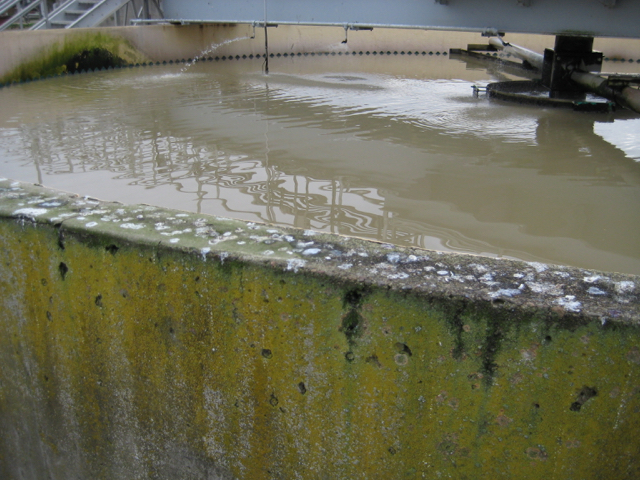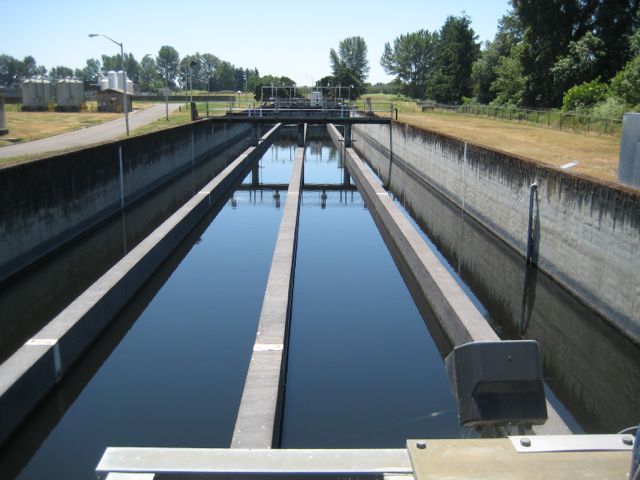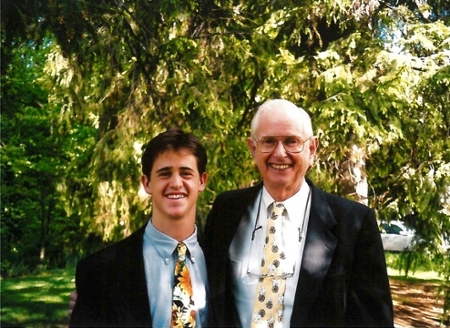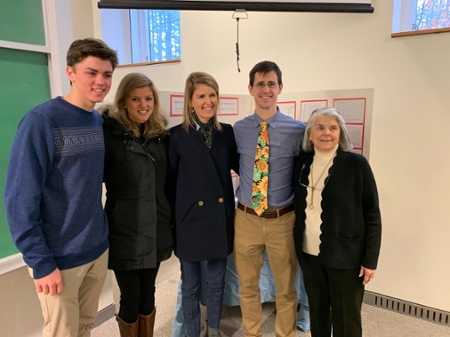Tracking Sewage to Protect the Environment
By Rebecca GoldfineSewage leaves millions of homes every day, headed to the wastewater treatment plant—which is where David Griffith '00, an environmental chemist, says things get really interesting.
Griffith is using an unexpected technique to find out important new information about the sewage we create and send back out into the world. In the process of pursuing his research, he's identified a cheap and easy way to eliminate one of the more toxic chemicals sewage often contains.
Where to Start?
A natural place for an environmental chemist to begin his or her work is the point where chemicals first enter our water systems—at wastewater treatment plants.
And so it was in the Hudson River area where Griffith says he first "got excited about sewage," when he was a graduate student at Yale University. Today, he is an assistant professor of chemistry at Willamette University in Oregon.
“I first got excited by being on the Hudson River near New York City, surrounded by all of these wastewater treatment plants that were discharging millions of gallons of sewage into the river every day, and trying to imagine the environmental and ecological consequences of those flows," he said.
After collecting water samples, Griffith employed an old technique in a creative way: he used radiocarbon dating to analyze the dissolved organic carbon in the wastewater and to see how carbon was moving in, interacting with, and transforming the Hudson River ecosystem.
Are Radiocarbons in Wastewater Old or New?
Using radiocarbon dating, Griffith made an important discovery. The carbon in the water was thousands of years old, meaning it wasn't all coming from the plants people were eating, say, in their salads. Much of it was instead derived from oil, coal, or other petrochemicals ingested as food additives, pharmaceuticals, or personal care products.
"Twenty-five percent of carbon in wastewater is petrochemically based," Griffith said. "This was one of my first ah-ha moments. We used the tools of analytical chemistry to learn something important about the system."
In the big picture, this finding shows that humans are discharging far more petrochemical carbon into the environment than earlier assumed, which has implications for how we view humans' carbon footprint and the global carbon cycle.
Radiocarbon dating has turned out to be a great gift to Griffith's research. He has since used the technique to glean insights into aquatic systems from the Arctic Ocean to Massachusetts Bay.

Are Estrogens in Water Synthetic or Natural?
In recent years, Griffith has turned his attention to estrogen in wastewater. In 2016, he received a National Science Foundation grant for over $325,000 to find out what happens to the hormone after it has been treated and emptied into rivers.
While humans naturally produce and excrete estrogen in our waste—as do fish and all other vertebrates—we also "dose ourselves with estrogen," Griffith said. We take birth control pills and feed our livestock hormones to fatten them up and keep them healthy. The problem with adding more estrogen to the environment is that even in very small quantities it can feminize fish populations, leading to a possible collapse of the stock. Certain forms of estrogen can also harm birds, amphibians, and mammals.
Griffith initially set out to determine how much estrogen in a water body comes from animals' biological processes, versus how much is coming from pharmaceutical products in wastewater. "If the main source is coming from sewage, then you can design processes that reduce the estrogen," he said.
“We should be able to design environmental considerations into these chemicals from the start, instead of designing the best chemical and then fixing the problem at the end, once it's out in the environment.”
—David Griffith '00
First he had to find a way to "fingerprint" or identify synthetic versus natural forms. By using radiocarbon dating, he could see that birth control pills have additional old fossil carbons, distinguishing them from estrogens naturally produced by vertebrates.
After Griffith identified these unique fingerprints, he was able to characterize the estrogen in Massachusetts Bay, off Boston's coast. He found that some estrogen is produced by fish and whales, while some comes from the city's 24-foot-wide, 9.5-mile-long sewer pipe—which every day empties millions of gallons of sewage onto the floor of the bay, under 100 feet of water.

Is the Sun a Solution?
In the process of studying the fate of estrogen in the sea, Griffith identified a relatively simple way wastewater treatment plants around the world can cheaply reduce the amount of estrogen in their systems, before releasing it into the environment.
A common final treatment step in wastewater facilities is to chlorinate water, basically by adding bleach, to kill off lingering pathogens. Unfortunately, this bleaching process transforms estrogen into a new form more likely to accumulate in animal tissue.
Yet, in an intriguing twist, Griffith found that when these chlorinated estrogens are exposed to sunlight, they degrade more quickly. So, if treatment facilities can expose chlorinated water to sunlight or UV lights, more of the estrogen flowing through them will degrade before being dumped into lakes, rivers, and oceans. (In his current research, he is continuing to investigate the estrogen photoproducts that result from sun exposure.)
"Some of the basins get covered up because of odor issues, which typically aren't all that bad, so if you open them up, you can encourage the degradation of estrogen and any other pharmaceutical that has this phenol group," Griffith said, including products like Tylenol and some detergents. "Many, many pharmaceuticals and personal care products have the same function group, so this would work for any of those."
Designing Harmless Chemicals
As a child growing up in Michigan, David Griffith spent his time in the outdoors and fishing, which he credits for influencing his later career choice. "I grew up enjoying healthy environmental systems and appreciating them," he said.
After graduating from Bowdoin in 2000, he worked as a fly fishing guide in the summers and a high school science teacher the rest of the year. He eventually returned to school to pursue a master's degree at the Yale School of Forestry, and a PhD in oceanography, applied ocean science, and engineering at Massachusetts Institute of Technology and Woods Hole Oceanographic Institute.
At Willamette University, Griffith said he teaches his students about the importance of intentionally designing chemicals to render them harmless at the end of their lives, after they are disposed of in the environment. "We should be able to design environmental considerations into these chemicals from the start," he said, "instead of designing the best chemical and then fixing the problem at the end, once it's out in the environment."

